
- •Table of Contents
- •1. Introduction
- •2. CodeVisionAVR Integrated Development Environment
- •2.1 Working with Files
- •2.1.1 Creating a New File
- •2.1.2 Opening an Existing File
- •2.1.3 Files History
- •2.1.4 Editing a File
- •2.1.5 Saving a File
- •2.1.6 Renaming a File
- •2.1.7 Printing a File
- •2.1.8 Closing a File
- •2.1.9 Using the Navigator
- •2.1.10 Using Code Templates
- •2.1.11 Using Clipboard History
- •2.2 Working with Projects
- •2.2.1 Creating a New Project
- •2.2.2 Opening an Existing Project
- •2.2.3 Adding Notes or Comments to the Project
- •2.2.4 Configuring the Project
- •2.2.4.1 Adding or removing a File from the Project
- •2.2.4.2 Setting the C Compiler Options
- •2.2.4.3 Executing an User Specified Program before Make
- •2.2.4.4 Transferring the Compiled Program to the AVR Chip after Make
- •2.2.4.5 Executing an User Specified Program after Make
- •2.2.5 Obtaining an Executable Program
- •2.2.5.1 Checking the Project for Syntax Errors
- •2.2.5.2 Compiling the Project
- •2.2.5.3 Making the Project
- •2.2.6 Closing a Project
- •2.3 Tools
- •2.3.1 The AVR Studio Debugger
- •2.3.2 The AVR Chip Programmer
- •2.3.3 The Serial Communication Terminal
- •2.3.4 Executing User Programs
- •2.3.4.1 Configuring the Tools Menu
- •2.4 IDE Settings
- •2.4.1 The View Menu
- •2.4.2 Configuring the Editor
- •2.4.3 Configuring the Assembler
- •2.4.4 Setting the Debugger Path
- •2.4.5 AVR Chip Programmer Setup
- •2.4.6 Serial Communication Terminal Setup
- •2.5 Accessing the Help
- •2.6 Transferring the License to another computer
- •2.7 Connecting to HP InfoTech's Web Site
- •2.8 Contacting HP InfoTech by E-Mail
- •2.9 Quitting the CodeVisionAVR IDE
- •3. CodeVisionAVR C Compiler Reference
- •3.1 The Preprocessor
- •3.2 Comments
- •3.3 Reserved Keywords
- •3.4 Identifiers
- •3.5 Data Types
- •3.6 Constants
- •3.7 Variables
- •3.7.1 Specifying the SRAM Storage Address for Global Variables
- •3.7.2 Bit Variables
- •3.7.3 Allocation of Variables to Registers
- •3.7.4 Structures
- •3.7.5 Unions
- •3.7.6 Enumerations
- •3.7.7 Global Variables Memory Map File
- •3.8 Defining Data Types
- •3.9 Type Conversions
- •3.10 Operators
- •3.11 Functions
- •3.12 Pointers
- •3.13 Accessing the I/O Registers
- •3.13.1 Bit level access to the I/O Registers
- •3.14 Accessing the EEPROM
- •3.15 Using Interrupts
- •3.16 SRAM Memory Organization
- •3.17 Using an External Startup File
- •3.18 Including Assembly Language in Your Program
- •3.18.1 Calling Assembly Functions from C
- •3.19 Creating Libraries
- •3.20 Using the AVR Studio Debugger
- •3.20.1 Using the AVR Studio Debugger version 3
- •3.20.2 Using the AVR Studio Debugger version 4.06 or later
- •3.21 Hints
- •3.22 Limitations
- •4. Library Functions Reference
- •4.1 Character Type Functions
- •4.2 Standard C Input/Output Functions
- •4.3 Standard Library Functions
- •4.4 Mathematical Functions
- •4.5 String Functions
- •4.6 Variable Length Argument Lists Macros
- •4.7 Non-local Jump Functions
- •4.8 BCD Conversion Functions
- •4.9 Gray Code Conversion Functions
- •4.10 Memory Access Functions
- •4.11 LCD Functions
- •4.11.1 LCD Functions for displays with up to 2x40 characters
- •4.11.2 LCD Functions for displays with 4x40 characters
- •4.11.3 LCD Functions for displays connected in 8 bit memory mapped mode
- •4.12 I2C Bus Functions
- •4.12.3 Philips PCF8563 Real Time Clock Functions
- •4.12.4 Philips PCF8583 Real Time Clock Functions
- •4.14 1 Wire Protocol Functions
- •4.14.3 Maxim/Dallas Semiconductor DS2430 EEPROM Functions
- •4.14.4 Maxim/Dallas Semiconductor DS2433 EEPROM Functions
- •4.15 SPI Functions
- •4.16 Power Management Functions
- •4.17 Delay Functions
- •5. CodeWizardAVR Automatic Program Generator
- •5.1 Setting the AVR Chip Options
- •5.2 Setting the External SRAM
- •5.3 Setting the Input/Output Ports
- •5.4 Setting the External Interrupts
- •5.5 Setting the Timers/Counters
- •5.6 Setting the UART or USART
- •5.7 Setting the Analog Comparator
- •5.8 Setting the Analog-Digital Converter
- •5.9 Setting the ATmega406 Voltage Reference
- •5.10 Setting the ATmega406 Coulomb Counter
- •5.11 Setting the SPI Interface
- •5.12 Setting the Universal Serial Interface - USI
- •5.13 Setting the I2C Bus
- •5.13.1 Setting the LM75 devices
- •5.13.2 Setting the DS1621 devices
- •5.13.3 Setting the PCF8563 devices
- •5.13.4 Setting the PCF8583 devices
- •5.13.5 Setting the DS1307 devices
- •5.14 Setting the 1 Wire Bus
- •5.15 Setting the 2 Wire Bus
- •5.16 Setting the CAN Controller
- •5.17 Setting the ATmega169/329/3290/649/6490 LCD Controller
- •5.18 Setting the LCD
- •5.19 Setting the USB Controller
- •5.20 Setting Bit-Banged Peripherals
- •5.21 Specifying the Project Information
- •6. License Agreement
- •6.1 Software License
- •6.2 Liability Disclaimer
- •6.3 Restrictions
- •6.4 Operating License
- •6.5 Back-up and Transfer
- •6.6 Terms
- •6.7 Other Rights and Restrictions
- •7. Technical Support
- •8. Contact Information
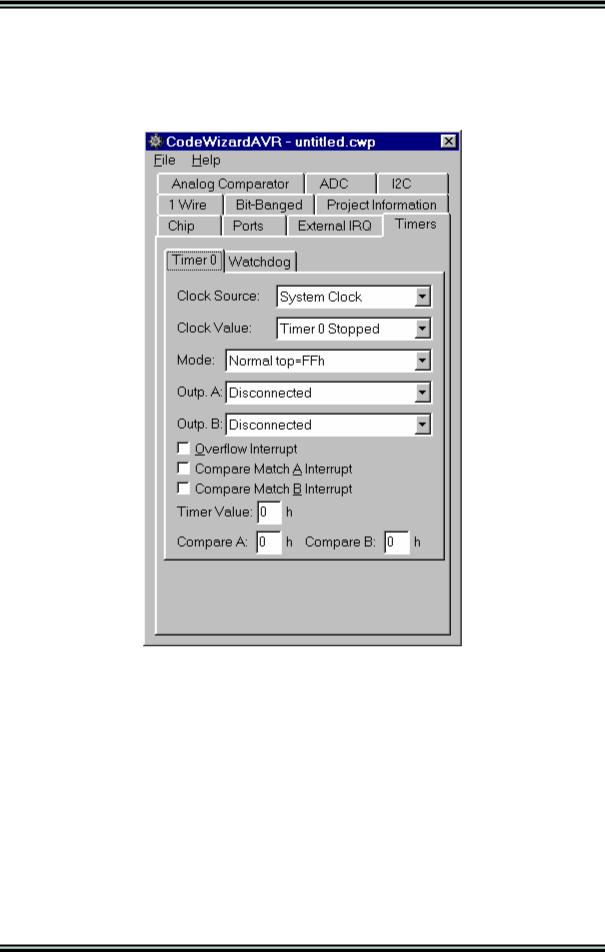
CodeVisionAVR
5.5 Setting the Timers/Counters
By selecting the Timers tab of the CodeWizardAVR, you can specify the timers/counters configuration.
A number of Timer tabs will be displayed according to the AVR chip type.
By selecting the Timer 0 tab you can have the following options:
•Clock Source specifies the timer/counter 0 clock pulse source
•Clock Value specifies the timer/counter 0 clock frequency
•Mode specifies if the timer/counter 0 functioning mode
•Outp. A specifies the function of the timer/counter 0 compare A output and depends of the functioning mode
•Outp. B specifies the function of the timer/counter 0 compare B output and depends of the functioning mode
•Overflow Interrupt specifies if an interrupt is to be generated on timer/counter 0 overflow
•Compare Match A Interrupt specifies if an interrupt is to be generated on timer/counter 0 compare A match
•Compare Match B Interrupt specifies if an interrupt is to be generated on timer/counter 0 compare B match
•Timer Value specifies the initial value of timer/counter 0 at startup
•Compare A specifies the initial value of timer/counter 0 output compare A register
•Compare B specifies the initial value of timer/counter 0 output compare B register.
© 1998-2007 HP InfoTech S.R.L. |
Page 187 |
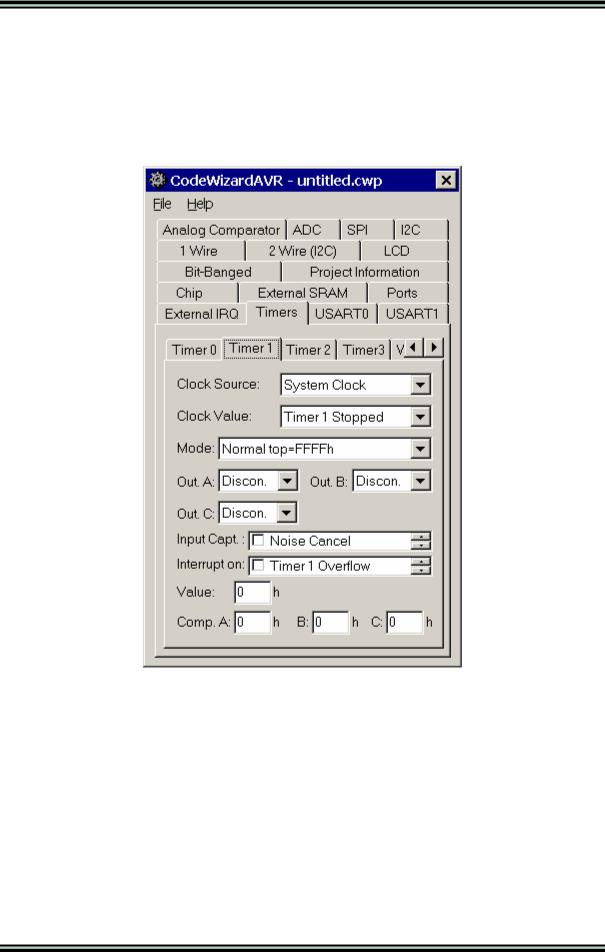
CodeVisionAVR
If timer/counter 0 interrupts are used the following interrupt service routines may be defined by the CodeWizardAVR:
•timer0_ovf_isr for timer/counter overflow
•timer0_compa_isr for timer/counter output compare A match
•timer0_compb_isr for timer/counter output compare B match
You must note that depending of the used AVR chip some of these options may not be present. For more information you must consult the corresponding Atmel data sheet.
By selecting the Timer 1 tab you can have the following options:
•Clock Source specifies the timer/counter 1 clock pulse source
•Clock Value specifies the timer/counter 1 clock frequency
•Mode specifies if the timer/counter 1 functioning mode
•Out. A specifies the function of the timer/counter 1 output A and depends of the functioning mode
•Out. B specifies the function of the timer/counter 1 output B and depends of the functioning mode
•Out. C specifies the function of the timer/counter 3 output C and depends of the functioning mode
•Inp Capt. specifies the timer/counter 1 capture trigger edge and if the noise canceler is to be used
•Interrupt on specifies if an interrupt is to be generated on timer/counter 1 overflow, input capture and compare match
•Timer Value specifies the initial value of timer/counter 1 at startup
•Comp. A, B and C specifies the initial value of timer/counter 1 output compare registers A, B and
C.
© 1998-2007 HP InfoTech S.R.L. |
Page 188 |
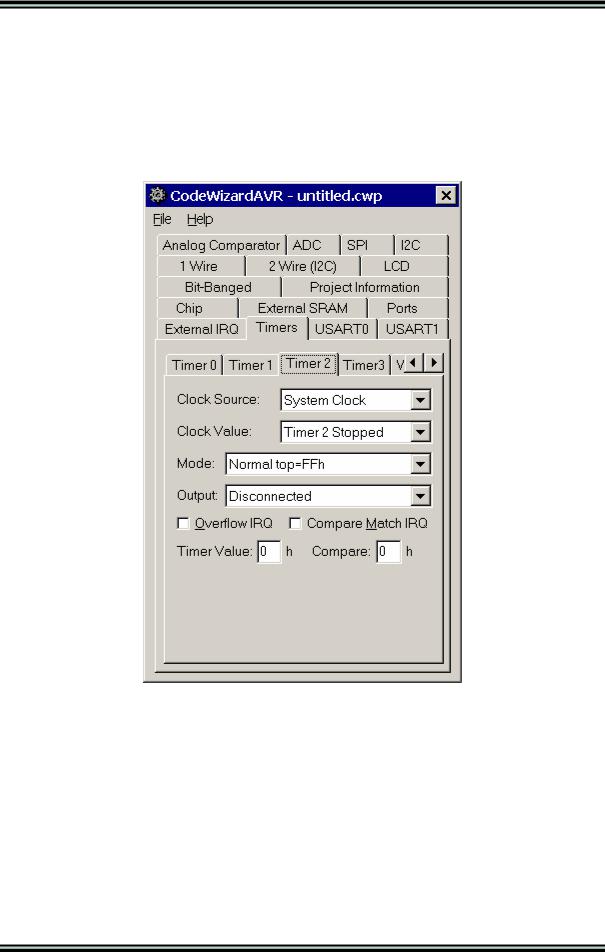
CodeVisionAVR
If timer/counter 1 interrupts are used the following interrupt service routines may be defined by the CodeWizardAVR:
•timer1_ovf_isr for timer/counter overflow
•timer1_comp_isr or timer1_compa_isr, timer1_compb_isr and timer1_copmc_isr for timer/counter output compare match
•timer1_capt_isr for timer/counter input capture
You must note that depending of the used AVR chip some of these options may not be present. For more information you must consult the corresponding Atmel data sheet.
By selecting the Timer 2 tab you can have the following options:
•Clock Source specifies the timer/counter 2 clock pulse source
•Clock Value specifies the timer/counter 2 clock frequency
•Mode specifies if the timer/counter 2 functioning mode
•Output specifies the function of the timer/counter 2 output and depends of the functioning mode
•Overflow IRQ specifies if an interrupt is to be generated on timer/counter 2 overflow
•Compare Match IRQ specifies if an interrupt is to be generated on timer/counter 2 compare match
•Timer Value specifies the initial value of timer/counter 2 at startup
•Compare specifies the initial value of timer/counter 2 output compare register.
© 1998-2007 HP InfoTech S.R.L. |
Page 189 |
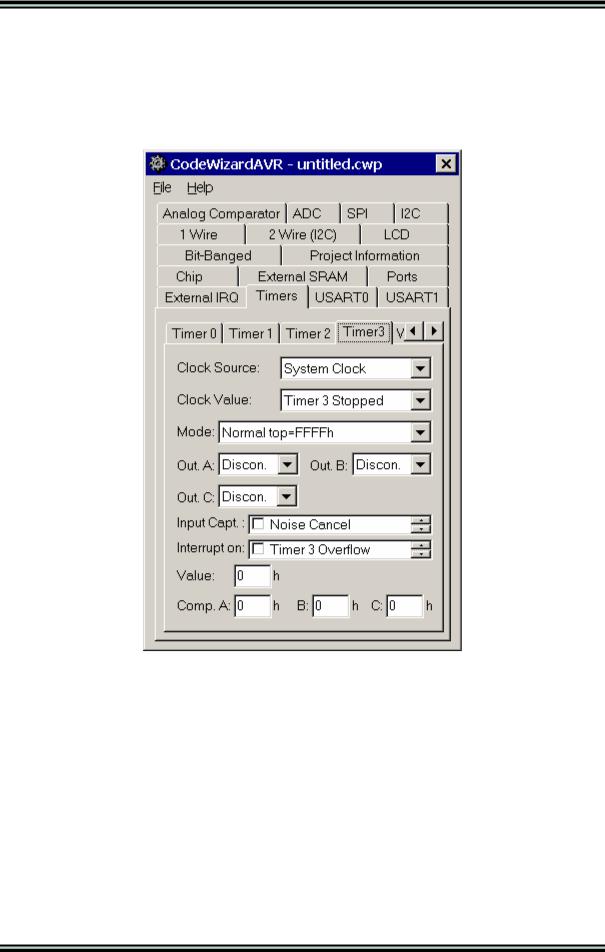
CodeVisionAVR
If timer/counter 2 interrupts are used the following interrupt service routines may be defined by the CodeWizardAVR:
•timer2_ovf_isr for timer/counter overflow
•timer2_comp_isr for timer/counter output compare match.
You must note that depending of the used AVR chip some of these options may not be present. For more information you must consult the corresponding Atmel data sheet.
By selecting the Timer 3 tab you can have the following options:
•Clock Source specifies the timer/counter 3 clock pulse source
•Clock Value specifies the timer/counter 3 clock frequency
•Mode specifies if the timer/counter 3 functioning mode
•Out. A specifies the function of the timer/counter 3 output A and depends of the functioning mode
•Out. B specifies the function of the timer/counter 3 output B and depends of the functioning mode
•Out. C specifies the function of the timer/counter 3 output C and depends of the functioning mode
•Inp Capt. specifies the timer/counter 3 capture trigger edge and if the noise canceler is to be used
•Interrupt on specifies if an interrupt is to be generated on timer/counter 3 overflow, input capture and compare match
•Timer Value specifies the initial value of timer/counter 3 at startup
•Comp. A, B and C specifies the initial value of timer/counter 3 output compare registers A, B and
C.
© 1998-2007 HP InfoTech S.R.L. |
Page 190 |
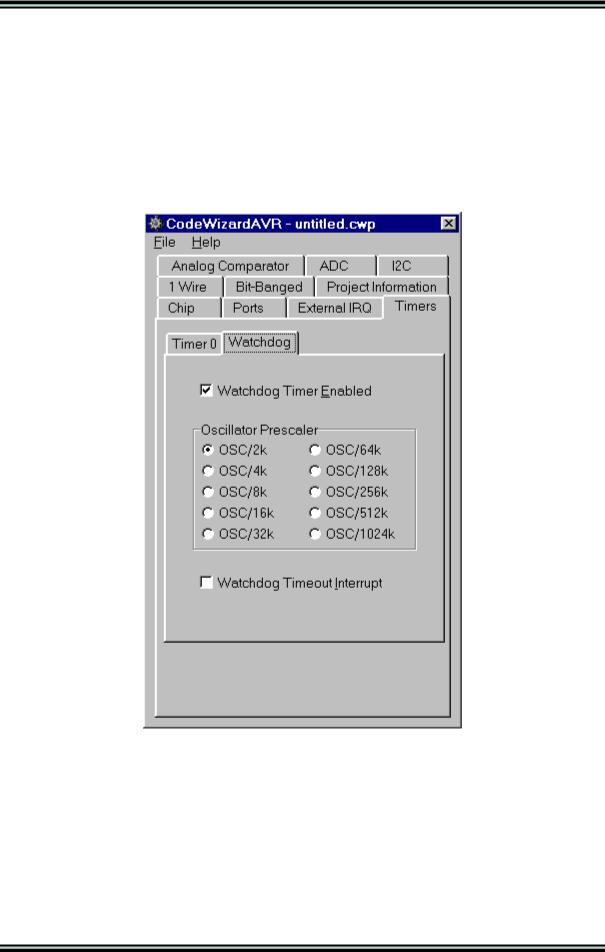
CodeVisionAVR
If timer/counter 1 interrupts are used the following interrupt service routines may be defined by the CodeWizardAVR:
•timer1_ovf_isr for timer/counter overflow
•timer1_comp_isr or timer1_compa_isr, timer1_compb_isr and timer1_copmc_isr for timer/counter output compare match
•timer1_capt_isr for timer/counter input capture
You must note that depending of the used AVR chip some of these options may not be present. For more information you must consult the corresponding Atmel data sheet.
By selecting the Watchdog tab you can configure the watchdog timer.
Checking the Watchdog Timer Enabled check box activates the watchdog timer. You will have then the possibility to set the watchdog timer's Oscillator Prescaller.
If the Watchdog Timeout Interrupt check box is checked, an interrupt will be generated instead of reset if a timeout occurs.
In case the watchdog timer is enabled, you must include yourself the appropriate code sequences to reset it periodically. Example:
#asm("wdr")
For more information about the watchdog timer you must consult the Atmel data sheet for the chip that you use.
© 1998-2007 HP InfoTech S.R.L. |
Page 191 |
